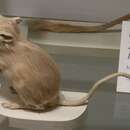fi
nimet breadcrumb-navigoinnissa


Kangaroo rats have a keen sense of smell, extraordinary hearing, and good night vision.
D. ordii individuals have an oil secreting gland located between the shoulders. They bathe regularily in sand to prevent the fur from becoming oily and matted. Secretions from the gland also allow D. ordii to distinguish individuals and sexes (Walker 1975).
Ord's kangaroo rats rarely make any vocal calls, the sounds that are made are usually soft squeaks. Instead they use their hind legs to make loud thumping noises in their burrow when the entrance is disturbed (Feldner 1996; Walker 1975).
Communication Channels: visual ; tactile ; acoustic ; chemical
Other Communication Modes: pheromones ; vibrations
Perception Channels: visual ; tactile ; acoustic ; vibrations ; chemical
Ord's kangaroo rats are one of the most common kangaroo rats. In western Canada, however, D. ordii is considered vulnerable.
US Federal List: no special status
CITES: no special status
IUCN Red List of Threatened Species: least concern
Ord's kangaroo rats do not adversely affect humans over most of their range. However in areas of Texas, D. ordii are reputed to do damage by gathering the seeds of newly planted crops (Davis and Schmidly 1994).
Negative Impacts: crop pest
Unknown
The diet of Ord's kangaroo rats is primarily composed of seeds. These seeds are gathered in fur lined cheek pouches for transport back to their burrows for storage. D. ordii forage for up to 25 yards from their burrow entrance. In the summer, D. ordii also feed on grasshoppers and moths. Water retention is very efficient in Ord's kangaroo rats and they use the water produced from metabolism for their bodily requirements. As a result, they have very little need for water consumption and will only drink water when absolutely necessary.
(Feldner 1996; Walker 1975)
Animal Foods: insects
Plant Foods: seeds, grains, and nuts
Foraging Behavior: stores or caches food
Primary Diet: herbivore (Granivore )
Dipodomys ordii are the most widespread of all Kangaroo rats. They are found through much of western North America from Saskatchewan to Mexico. The Kansas plains, Great Sandhills of Sakatchewan and the California sagebrush are all common habitats. (Banfield 1974; La Flamme 2000)
Biogeographic Regions: nearctic (Native )
D. ordii can be found on the riverbanks and the Great Sand Hills of Saskatchewan, throughout the Kansas plains, and the deserts of the southwestern United States (Banfield 1974; La Flamme 2000; Walker 1975).
In general, D. ordii prefers arid climates with sparse vegetation covering the sandy ground. Open ground is better for this animal, as it has been observed that an increase in grass cover leads to a decrease in population. Their burrows are rarely located in hard and gravelly soils and they are one of the few animals that are able to establish in shifting dunes (Banfield 1974; Davis and Schmidly 1994).
Habitat Regions: temperate ; terrestrial
Terrestrial Biomes: desert or dune ; savanna or grassland
Other Habitat Features: agricultural
Average lifespan
Status: captivity: 9.8 years.
Total length ranges from 210-365 mm in males, and 208-360 mm in females. Tail length is, on average, 129 mm in males and 127 mm in females. The long tail is dark on top with two white bands on each side tapering to a grey tuft of longer hairs at the end. Ord's kangaroo rats have small forelimbs and long, strong hindlegs which are modified for jumping (Feldner 1996; Walker 1975).
Coloration of the long silky fur is rich and tawny on top with a scattering of black hairs along the middorsal line. D. ordii have distict white markings which include underparts of the feet, upper lip, spots above the eyes and across the hips.
There are no pelage differences between males and females but there are seasonal variations in weight for all D. ordii. Their weight peaks around mating season (Banfield 1974).
Range mass: 55 to 96 g.
Other Physical Features: endothermic ; homoiothermic; bilateral symmetry
Sexual Dimorphism: sexes alike
Average basal metabolic rate: 0.339 W.
In encounters with particularily threating predators, D. ordii will turn around and face away from the enemy and use their hind legs to spray sand into the enemy's eyes. D. ordii can evade predators with long jumps measuring up to 2 meters long.
D. ordii are solitary animals that will only let potential mates approach during the mating seasons in spring and fall. Exact timing of mating seasons varies geographically. Females breed only when there is a favorable moist season, few breed during drought.
During estrus, which lasts for a few days, this species will pursue each other playfully. With an approximate gestation period of a month and sexual maturity at 2 months, the population can expand rapidly after a favorable season. (Banfield 1974)
Breeding interval: Ord's kangaroo rats breed when conditions are appropriate, with abundant food sources for both mother and young.
Breeding season: Breeding seasons are typically in the spring and fall, but vary throughout the range of Ord's kangaroo rats.
Average age at sexual or reproductive maturity (female): 2 months.
Average age at sexual or reproductive maturity (male): 2 months.
Key Reproductive Features: iteroparous ; seasonal breeding ; gonochoric/gonochoristic/dioecious (sexes separate); sexual ; viviparous
Average birth mass: 5 g.
Average gestation period: 29 days.
Average number of offspring: 3.
Average age at sexual or reproductive maturity (female)
Sex: female: 61 days.